 |
|
|
|
|||||
|
 . . |
In
the first section of this course these are the following things for you
to do.
|

5. content to put on the pages on the web site content is usually described as including
- eg. WS FTP |
Creating a
web page
to create a web page you need 1. computer
|
 |
Creating a web page -
to create a web page you need
6. software to make and edit web pages (HTML editors)
For the purposes of this
course, it might be best to use Netscape Composer - which is free, and
comes with Netscape Communicator, which you can download free from www.netscape.com
|
 |
Creating a web page -
Web Document Structure Tags
http://www.cwru.edu/help/introHTML/TCh2.html This page specifically talks about the document structure tags in simple to understand format. |

|
HTML
Editors
Rick Darnell says that "one of the main drawbacks to working with HTML is that many Web page editors don't display a page the way it will look on a browser ...this situation is changing with the advent of WYSIWYG editors that display a page using the standard accepted by most browsers." There are 2 basic types
of HTML Editors:
Go to Tucows (click on icon to the left) to browse through several of the Advanced HTML editors. You will find HoTMetaL, HotDog and WPC on the list as well as others. A short list Review of some
of the more popular HTML Editors, including links to their downloads http://www.qsystems.net/pub/html.htm
|
| HTML
basics |
HTML basics
can be viewed at http://www.witiger.com/senecacollege/BCS500.htm
This is a course taught at another institution but you are free to use these pages to teach yourself HTML cause the pages for the course are hosted by Prof. Richardson on his own domain. 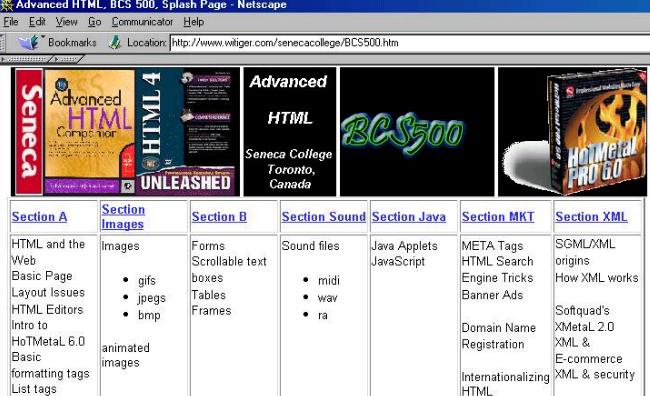
.
|
| . | Creating a web page
to create a working e-commerce site, you need 1. a product or service to
sell
|
| . | Here
is an example of why you would need to know about the HTML document structure
tags on a page, even if you were in marketing and someone else designed
the page.
To "get found" search engines use META TAGS as part of the information they use to index and retrieve pages. META TAGS are located within the HEAD TAGS on a page. This information is a collection of choice words used to help the page rank high in searches - if you know this, you can look at the HTML code on competitors' pages and see what words they used in their META TAGS, and change your META TAGS accordingly. Another
example:
For
instance, the title tags for this page are
WTGR |
.
|
Plug-ins |
.
A plug-in, sometimes called a browser extension, enhances the ability of the browser to see and read content (images and text) on the displayed page, which your browser might not normally be able to see with the standard installation. Most plug-ins are developed
by third party vendors who create plug-ins and make them available through
various web sites.
|
where to find an image editor
when you are using the BSC labs at Seneca.

.
| . | The reason why you need
to familiarize yourself with a good image editor in making pages, is because
the images you collect to put on your page may need to be resized, or cropped,
to fit more appropriately. Smaller images will help the page load faster
so do not use large images unless it is necessary, always try to crop you
images, or make them thumbnails which can be clicked on to view a larger
version.
WTGR |
. |
Creating
a web page : to create a web page you need
7. software to send the pages to the hosting server - eg. WS FTP Once you have made the pages,
either in an editor like Netscape Composer, or HoTMetaL, or
Uploading is easy using WS-FTP. It's like using Windows Explorer - with the left hand of the screen showing the files on your computer, and the right half of the screen showing the files on your server. 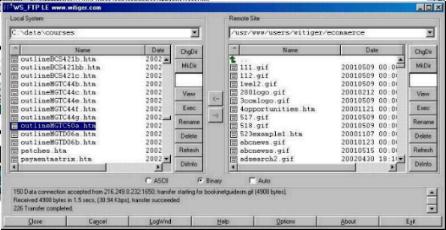
.
|

.
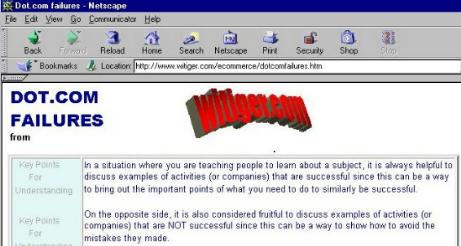 |
Before we get involved in the details of e-commerce, it is useful to look at some examples of things people have done which did not work out so well - so, we will make sure we do not make the same mistakes |
| Terminology | It used to be in 1998 /
1999 that e-commerce was the general term used to explain the aspects of
setting up a web site to actually conduct transactions over the WWW and
e-business was a catch-all phrase for everything else.
However by early 2000,
|

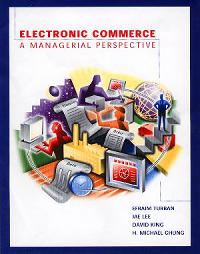 |
Interdisciplinary nature
of e-Commerce (e-Business)
(1st edition p. 13, 14) (2nd edition p. 14, 15) - these books are not necessary to buy for MRK 610 - most of the material you need to understand will be listed in www.witiger.com Interdisciplinary nature
of e-Commerce (e-Business)
|


Chapter 1 |
Benefits to organizations
that use e-Commerce (e-Business)
- you should understand some of these points in order that you can explain it so someone else that might be a posible client
|


Chapter 1 |
Benefits to consumers
that use e-Commerce (e-Business)
|


Chapter 1 |
Limitations of e-Commerce
(e-Business)
- you should understand some of the and be able to explain these to a potential client because not everyone is convinced the internet will be a major way to conduct business - example TV has been around for a long time - but only a small percentage of all companies advertize on TV !!
|


Chapter 1 |
|
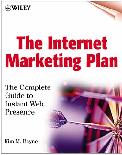 from the introduction to
Kim Bayne's book
|
.
You do not have to buy the Bayne book, it is here just for reference. Bayne has some wise words at the beginning of the book about the "environments", which merit summarizing here. "When the first edition of the book was published, the climate for Internet marketing was very different. Much has happened in the past few years to change the e-business landscape . For one thing, the major players are no longer "pure Internet players" ... The Web is now just another mainstream den of big business ...today, companies jump online without much forethought or are driven into the situation by outside forces" Let's look at those "outside forces" The forces that effect companies who are moving from "brick and mortar" to "click and mortar" are
|
| . | When the professor is
explaining.
WTGR |